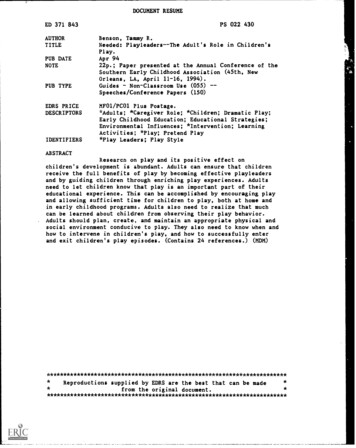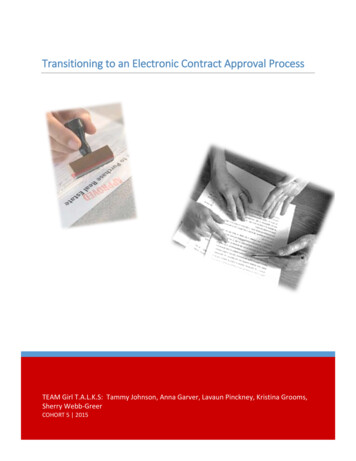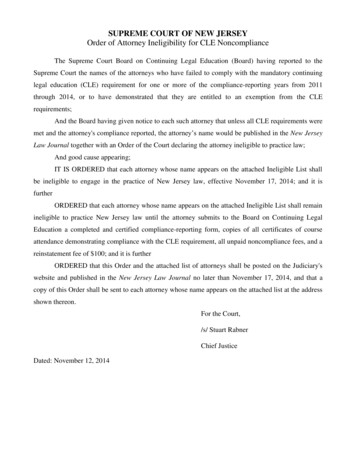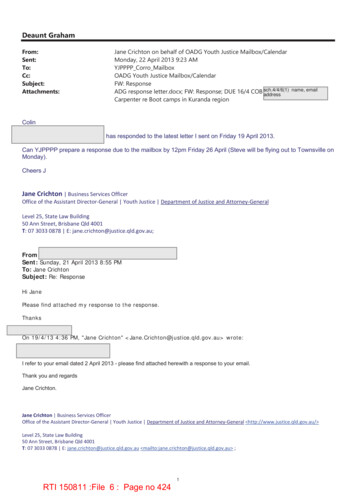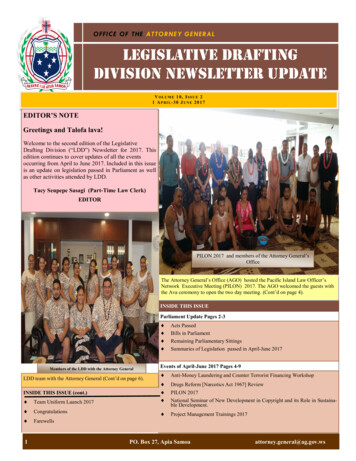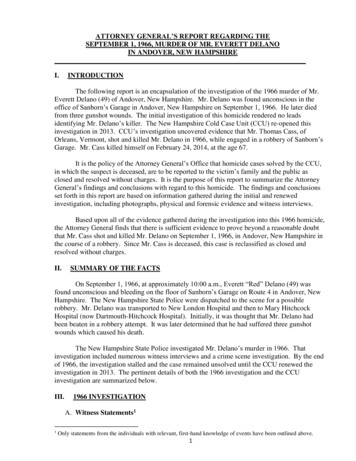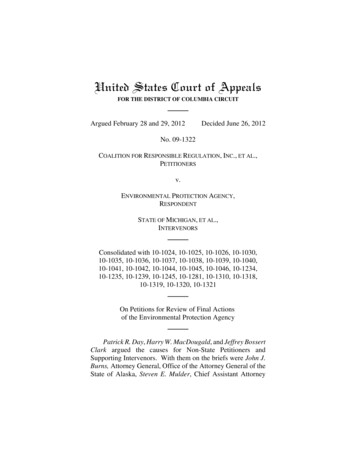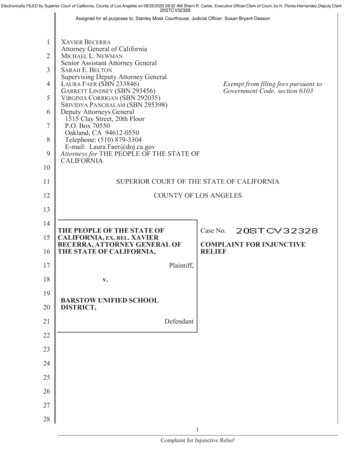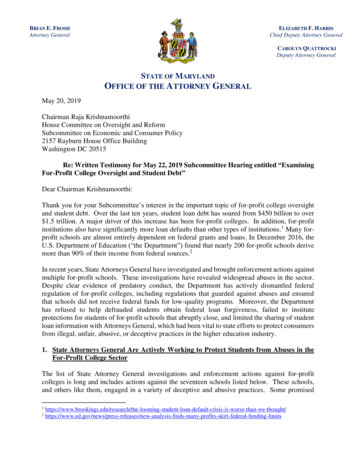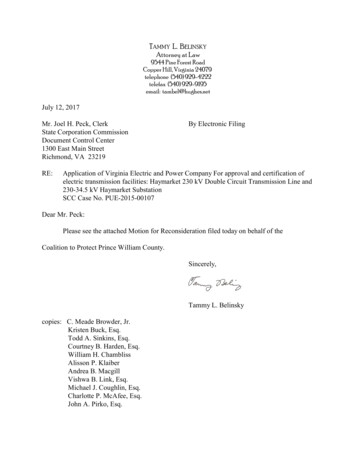
Transcription
TAMMY L. BELINSKYAttorney at Law9544 Pine Forest RoadCopper Hill, Virginia 24079telephone (540) 929-4222telefax (540) 929-9195email: tambel@hughes.netJuly 12, 2017Mr. Joel H. Peck, ClerkState Corporation CommissionDocument Control Center1300 East Main StreetRichmond, VA 23219RE:By Electronic FilingApplication of Virginia Electric and Power Company For approval and certification ofelectric transmission facilities: Haymarket 230 kV Double Circuit Transmission Line and230-34.5 kV Haymarket SubstationSCC Case No. PUE-2015-00107Dear Mr. Peck:Please see the attached Motion for Reconsideration filed today on behalf of theCoalition to Protect Prince William County.Sincerely,Tammy L. Belinskycopies: C. Meade Browder, Jr.Kristen Buck, Esq.Todd A. Sinkins, Esq.Courtney B. Harden, Esq.William H. ChamblissAlisson P. KlaiberAndrea B. MacgillVishwa B. Link, Esq.Michael J. Coughlin, Esq.Charlotte P. McAfee, Esq.John A. Pirko, Esq.
COMMONWEALTH OF VIRGINIASTATE CORPORATION COMMISSIONAPPLICATION OFVIRGINIA ELECTRIC AND POWER COMPANYCASE NO. PUE-2015-00107For approval and certification of electric transmissionFacilities: Haymarket 230 kV Double CircuitTransmission Line and 230-34.5 kV Haymarket SubstationMOTION FOR REHEARING OR RECONSIDERATIONCOMES NOW, the Coalition to Protect Prince William County (the "Coalition"), bycounsel, and in accordance with the provisions of 5 VAC 5-20-220, respectfully presents thisMotion for Rehearing or Reconsideration of the Final Order of the State Corporation Commission("Commission") dated June 23, 2017 ("Order"). On March 8, 2017, Dominion’s customer admittedbefore the Army Corps of Engineers that its block load electric services requirement which servesas the basis of the application does not currently exist and may not exist in the future.INTRODUCTION AND SUMMARY OF ARGUMENTVirginia Electric and Power Company, d/b/a Dominion Virginia Power ("Dominion" or"Company"), is seeking a certificate of public convenience and necessity ("CPCN") pursuant toVa. Code § 56-46.1 in order to construct certain electric transmission and distribution facilities toserve the needs of an existing retail customer (the "Customer") in Prince William County,Virginia. The Customer, while currently receiving adequate service from the Company, nowdesires to receive new service for a proposed data center campus near the Town of Haymarket.Dominion's application states that the facilities "are necessary so that [the Company] can
Provide service requested by a retail electric service customer . for a new data center campus inPrince William County, Virginia." 1 Dominion has stated that the Project would not be needed,and would not have been proposed, absent the request for new service by the Customer. 2Dominion also admits that the Project has been designated as a "Supplemental Project" by PJMmeaning that it is not needed for grid reliability. 3The Project would entail, among other things, converting an existing 115 kV line to 230kV operation and constructing a new 230 kV line to run approximately 5.1 miles from a pointnear the existing Gainesville Substation to a new 230-34.5 kV Haymarket Substation. 4 TheHaymarket Substation would be located on land currently owned by the Customer. TheCompany states that "the new facilities must be in service by summer (commencing June 1) of2018 to serve the Customer's development at the Haymarket Campus." 5The Commission should reconsider its Order authorizing Dominion VirginiaPower("Dominion"), to construct and operate the Project, as set forth in the Final Order, along theCarver Road Route, including the variance identified therein, if the Company is unable to obtainan easement from Prince William County, for the following reasons: (1) the Customer hasintroduced new evidence that challenges the “need” that serves as the basis of Dominion’sapplication; and (2) the Order contravenes Virginia statutory and constitutional law to the extentit authorizes the taking of private property when the Commission has found that the "need" for theTransmission Line is driven by a single retail customer.Application at 2.See Exhibit 5.3See, e.g., Tr. 110-111, 469, 569-570.4Application at 2.5Application at 2.12
ARGUMENTI.THE CUSTOMER HAS INTRODUCED NEW EVIDENCE THATCHALLENGES AND CHANGES THE “NEED” THAT SERVES AS THEBASIS OF DOMINION’S APPLICATIONThe Commission cannot approve Dominion’s application in the absence of a finding thatthere is a clear need for the Transmission Line. VA Code § 56-265.2A provides that "it shall beunlawful for any public utility to construct . . . facilities for use in public utility service . withoutfirst having obtained a certificate from the Commission that the public convenience andnecessity require the exercise of such right or privilege." Additionally, VA Code § 56-46.1provides, in part, that: “As a condition to approval the Commission shall determine that the lineis needed and that the corridor or route the line is to follow will reasonably minimize adverseimpact on the scenic assets, historic districts and environment of the area concerned. . .” TheCustomer has proposed to enter into a Memorandum of Agreement (MOA) with the Army Corpsof Engineers (COE) and Virginia Department of Historic Resources under Section 106 of theNational Historic Preservation Act (NHPA). The Midwood project, a proposed data center withassociated infrastructure, is located within the Core of the Buckland Mills Battlefield (DHR ID#030-5152) in Haymarket, Virginia. The Buckland Mills Battlefield is eligible for listing on theNational Register of Historic Places.The customer has requested a State Program General Permit (12-SPGP-01) from theNorfolk District Corps of Engineers under Section 404 of the Clean Water Act for the permanentdischarge of fill material into 991 linear feet of stream channel and 0.10-acre palustrine forestedwetlands as well as the temporary discharge of fill into 14 linear feet of stream channel. Thedischarge of fill is associated with the construction of a proposed 3 building data center complex
and its associated infrastructure. Issuance of this permit constitutes a Federal undertaking,subject to Section 106 of the National Historic Preservation Act.At the initial meeting of the Section 106 consulting parties on March 8, 2017, Attorneysfor the Customer asserted unequivocally that: (1) Building One is complete and operational usingexisting electrical utility infrastructure; (2) Building Two would operate without the requirementfor additional electrical utility infrastructure; (3) The electric transmission and distributionfacilities delineated in Dominion’s application would not be required until Building Three wasoperational; (4) Buildings Two and Three were not projected to be built in the foreseeable future,if ever, as construction would only occur if expanded capacity were required in the future by theCustomer. See, Affidavits of Grymes, Holmes, Marshall, Schlossberg and Weir attachedherewith.The question in this case is whether there is a need. Those assertions contradict the “need”that serves as the basis of Dominion’s application, namely that (1) “The electric facilities proposedin this application are necessary so that Dominion Virginia Power can provide service requestedby a retail electric K service customer (the "Customer") for a new data center campus in PrinceWilliam County, Virginia and maintain reliable electric service to its customers in the area inaccordance with mandatory North American Electric Reliability Corporation ("NERC")Reliability Standards for transmission facilities and the Company's planning criteria; 6 (2) “Theproposed new facilities must be in service by summer (commencing June 1) of 2018 to serve theCustomer's development at the Haymarket Campus in Prince William County, Virginia”; 7 (3) “Thetotal Customer load at Haymarket Campus is projected to be approximately 120 MVA, consistingof three buildings. The proposed new electric transmission facilities must be in service by June of67Application at 2.Application at 5.
2018 to serve the Customer's new development. The total loading at Haymarket Substation,including the Customer's load, is projected to be approximately 160 MVA at full build-out”. 8As noted above, the in-service date for the proposed facilities is summer (commencingJune 1) 2018, with an estimated 12 months for construction of the Project and a period of 12months for engineering, material procurement, right-of-way acquisition and constructionpermitting. 9 Notwithstanding that those estimates by Dominion which render the completion ofthe project by the in-service date practically impossible (by the Customer’s own admission) it doesnot currently and will not in the foreseeable future generate the 120 MVA requirement that servesas the basis for Dominion’s application, thereby invalidating the basis of the instant application.The 120 MVA requirements will commence only upon the completion of both Buildings Two andThree. At present the planning, permitting and construction of Buildings Two and Three cannotbegin until such time as the Section 106 proceeding is complete, and the COE issues the requiredpermits that would authorize the construction of Buildings Two and Three in locations currentlyencumbered by an intermittent stream and identified wetlands.In support thereof, the Coalition notes that the Customer “has not requested BuildingPermits for buildings #2 and #3”. 10 Similarly, Dominion has not filed an application for the SpecialUse Permit required to construct the proposed substation that is to be located on a parcel adjacentto the Customer’s site. Thus, as a practical matter, the in-service date of June 1, 2018 is nowunattainable.Even if Dominion finalizes the route and secures the required permits, by their ownadmission it would take 12 months for engineering and another 12 months for constructionApplication at Appendix 1, Part 1Application at 7.10June 28, 2017 email from Wade HughPrince William County Department of Development Services89
resulting in an in-service date of no sooner than July 1, 2019. When coupled with the likelyrequirement for COE permits for a portion of the substation location and segments of thetransmission line route, a process also subject to review under Section 106 of the National HistoricPreservation Act and likely to continue for months if not years, completion is not likely until 2020at the earliest. Further additional “delays” are likely in the form of COE review and permitting ofportions of the final power line route (applications that have yet to filed); Prince William Countyreview and approval of the Special Use Permit for the proposed substation (yet to be filed), andcondemnation proceedings required to take properties required for completion of the project.Accordingly, even if Dominion were to complete the planning, engineering and landacquisition to construct the project, Dominion could not begin construction of the project untilsuch time as the facilities at the western terminus of the transmission line (Buildings Two andThree as well as the required substation) are approved and permitted. To do otherwise wouldconstitute the construction of a speculative transmission line to “nowhere” at the ASTATUTORYANDCONSTITUTIONAL LAW TO THE EXTENT IT AUTHORIZES THETAKING OF PRIVATE PROPERTY WHEN THE COMMISSION HASFOUND THAT THE “NEED” FOR THE TRANSMISSION LINE IS DRIVENBY A SINGLE RETAIL CUSTOMERThe question of need has not been adequately addressed by the Commission in the contextof the facts and circumstances of this case. Notwithstanding the arguments detailed in Section I,all parties, including the Commission itself, recognize that the application is driven by the allegedneed of a single retail customer that has requested additional service capacity from Dominion 11.Yet, in issuing the Order, the Commission made a conclusory determination of need without11Interim Order at p. 10.
engaging in substantive analysis of the evidence before the Commission that Dominion has failedto demonstrate a need for this Transmission Line in accordance with the requirements of Virginialaw.The Commission cannot approve Dominion’s application in the absence of a finding thatthere is a clear need for the Transmission Line. VA Code § 56-265.2A provides that "it shall beunlawful for any public utility to construct . . . facilities for use in public utility service . withoutfirst having obtained a certificate from the Commission that the public convenience and necessityrequire the exercise of such right or privilege." Additionally, VA Code § 56-46.1 provides, in part,that: “As a condition to approval the Commission shall determine that the line is needed and thatthe corridor or route the line is to follow will reasonably minimize adverse impact on the scenicassets, historic districts and environment of the area concerned. . .” The question in this case iswhether there is a need.Indeed, a careful review of the record reflects that there is insufficient evidence to establisha need for the proposed 230 kV double circuit Transmission Line and Haymarket substation. It isclear from the Application and the evidence in the record that the sole purpose of the proposedTransmission Line is to provide service to a single end-user, referred to in the Application as the“Customer”. 12 This raises a legitimate question as to whether there is a need for the constructionof the proposed Transmission Line to provide service to the existing customer base and theanticipated customer base that is consistent with Prince William County’s adopted ComprehensivePlan or whether the Application is about the need of one private customer.Application, p. 2; Application Appendix, DEQ Supplement, Direct Testimony and Exhibits of Virginia Electric andPower Company, p. 2; and Appendix to Application, p. 1.12
In 2007, the Virginia General Assembly amended Virginia Code Section 56-46.1 for thepurpose of giving localities greater say in transmission line siting. 13 In 2011, the statute wasamended again to require an applicant to demonstrate, in its filing, its efforts to "reasonablyminimize adverse impact on the scenic assets, historic districts, and environment of the areaconcerned." 14 And in 2016, the statute was amended to provide that "the governing body of anycounty or municipality through which the line is proposed to be built" may petition theCommission to hold a public hearing in the affected area. 15 Currently, both the Hearing Examinerand Dominion have ignored the fact that the General Assembly has amended Virginia CodeSection 56-46.1 multiple times in recent years for this very purpose - that is, to give localgovernments and affected property owners a greater say in the approval and siting of transmissionfacilities.Indeed, the Commission’s own staff recognized that the proposed Transmission Line’sconstruction to serve a single customer’s projected load raises doubt that there is a “public interest”in the stated need for the proposed Transmission Line. 16 In its comments, the Commission’s Staffrecognized that: “Even when load for a single customer does materialize, retail customers still beara disproportionate share of the environmental and construction costs associated with the necessarytransmission line, while one customer enjoys the benefits”. 17 Additionally, during its openingstatements at the evidentiary hearing, the Commission’s staff stated that: “what this case boilsdown to” is: “[C]an a retail customer, currently receiving perfectly adequate service at distributionlevels, demand an increase in its service so significant that it requires construction of new2007 Acts of Assembly, Ch. 761.2011 Acts of Assembly, Ch. 243.152016 Acts of Assembly, Ch. 276.16See Staff Comments Dated December 6, 2016 at p. 3.17Id.1314
transmission facilities without incurring any financial responsibility for its request?” 18 It is clearthat the Commission Staff found the only reason for the subject application is a single retailcustomer’s dramatic proposed increase in demand for electricity, and a private contract betweenDominion and that retail customer to address the proposed increase.The Application itself establishes that the alleged “need” only exists as a result of a privateagreement between Dominion and a third party (the Customer).Dominion has stated thefollowing: 1) that Line #124 is currently being operated at 115 kV; 19 2) that the Customer requiresa load of 120 MVA; 20 3)that once the proposed Project is complete, the total load of Line #124,at full buildout of the Customer’s campus, will be 160 MVA. 21 Otherwise stated that Line #124is adequate for the current load and indeed, all anticipated future development, if such futuredevelopment does not include the Customer’s data center. 22In responding to the Staff’s discovery questions regarding necessity, Dominion failed toprovide clear or adequate answers to establish the need for the Transmission Line. For example,Staff’s First Set of Discovery, Interrogatory No. 13 asks: “Would NERC or PJM requirementsprohibit the Company from amending its Transmission Planning Criteria to create a different loadlimit for radial transmission lines that are needed for a line extension to serve a single customer,such as a data center?” In other words, why are these load limit “standards” in place and is itbecause it will maximize Dominion’s profits or, in the alternative, because there is a federallymandated requirement for them to be in place? Dominion’s response was revealing. The responseindicated that there is no reason Dominion cannot change its load requirements, except thatHwy. Tr. 102:3 – P.Application, p. 2.20Application, p. 2.21Application, p. 2.22It should be noted that there is data center customer already being served by Line #124 whose demand is 19.5.See, Dominion’s responses to Staff’s First Set Discovery, Interrogatory No. 12.1819
Dominion believes “that making an exception based entirely on the type of customer (i.e., datacenters) or number of customers that make up the 100 MW load could ultimately reducereliability and negatively impact economic development, as well as could be inconsistent with theCompany’s responsibility to provide non-discriminatory service.” 23 (emphasis added). Dominionbears the burden to demonstrate the need for this Project. That the Project “could be” necessaryis insufficient. Dominion has submitted no evidence that the proposed 230 kV double circuitTransmission Line is necessary to meet its obligation as a public utility to provide electricityservice to customers located in and around the proposed routes. Dominion simply speculates thatit might require additional service in the future to meet the needs of future economic development.On this point, the Commission’s own staff raised legitimate concerns regarding whether there wasevidence of an actual need given the lack of certainty regarding future economic development. Inits Brief, the Staff stated: “while DVP is confident that the single Customer's load will bedeveloped as scheduled, Staff is aware (as is the Company) of at least two recent cases in which atransmission line was built for one customer's projected load, but that load failed to materialize.”24Similarly, Staff’s First Set of Discovery, Interrogatory No. 6 requests, “[p]lease providethe Company’s basis for uprating Line #124 from 115 kV to 230 kV.” Dominion’s response doesnot focus on any actual need for the Transmission Line but rather provides a basis for why itbelieves Dominion is entitled to receive an upgrade of its infrastructure: “Converting Line #124Dominion responses to Staff’s First Set Discovery Interrogatory No. 13.See Staff Brief at p. 15-l7; see Application of Virginia Electric and Power Company d/b/a Dominion VirginiaPower, For approval and certification of electric transmission facilities in Prince William County and the City ofManassas: Cannon Branch-Cloverhi
Attorney at Law 9544 Pine Forest Road Copper Hill, Virginia 24079 telephone (540) 929-4222 telefax (540) 929-9195 email: tambel@hughes.net July 12, 2017 Mr. Joel H. Peck, Clerk By Electronic Filing State Corporation Commission Documen
